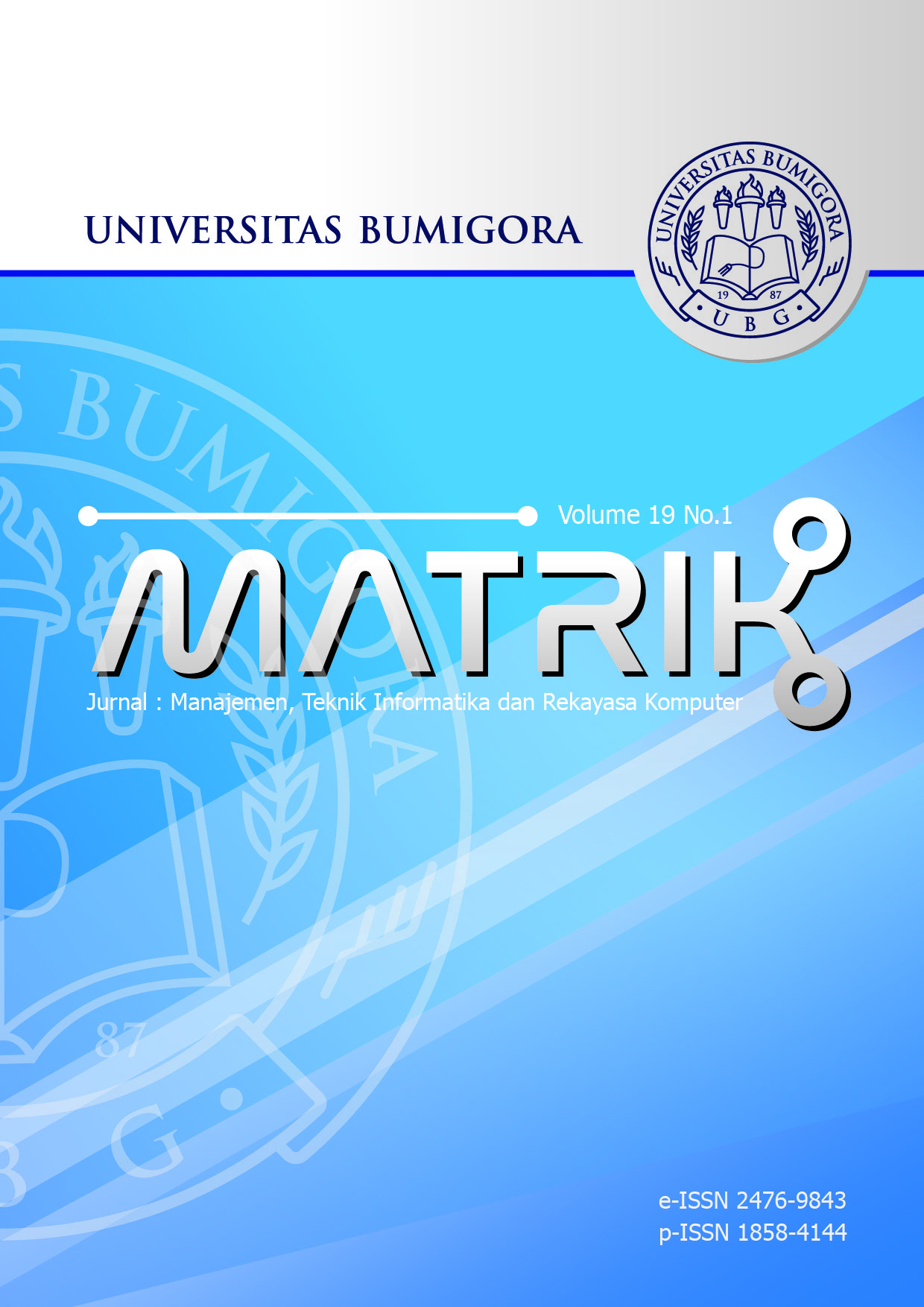Pengenalan Plat Kendaraan Bermotor dengan Menggunakan Metode Template Matching dan Deep Belief Network
DOI:
https://doi.org/10.30812/matrik.v19i1.475Keywords:
deep belief network, vehicle plat, template matching, python, identificationAbstract
The license plate of the vehicle is unique and is only owned by one vehicle per vehicle plate series, to make it easier for the police, especially the traffic police, to track traffic violators through the vehicle number plate. The Deep Belief Network algorithm works by processing the dataset through 3 stages, where the first layer is trained, the results of the first layer are then re-trained, and the results of the second layer calculation are made into the third layer count, the mean results on the calculation of the third layer become the result of learning Deep Belief Network then with the Template Matching algorithm, Deep Belief Network is assisted with the introduction of vehicle plates. In a study conducted using the DBN algorithm with the Template Matching method succeeded in recognizing a vehicle plate with a success percentage of 80% from 20 trials. The experiments carried out included plates that were not clearly seen. Failures that occur in the trials are generally due to under- or over-lighting on the vehicle plate.
Downloads
Downloads
Published
Issue
Section
How to Cite
Similar Articles
- Willy Riyadi, Jasmir Jasmir, Performance Prediction of Airport Traffic Using LSTM and CNN-LSTM Models , MATRIK : Jurnal Manajemen, Teknik Informatika dan Rekayasa Komputer: Vol. 22 No. 3 (2023)
- Yunanri W, Ammar Fauzan, Ahmad Yani, Muhammad Abdul Aziz, Analisis Performance Central Prosessing Unit (CPU) Realtime Menggunakan Metode Benchmarking , MATRIK : Jurnal Manajemen, Teknik Informatika dan Rekayasa Komputer: Vol. 20 No. 2 (2021)
- Umar Aditiawarman, Alfian Dody, Teddy Mantoro, Haris Al Qodri Maarif, Anggy Pradiftha, Evading Antivirus Software Detection Using Python and PowerShell Obfuscation Framework , MATRIK : Jurnal Manajemen, Teknik Informatika dan Rekayasa Komputer: Vol. 22 No. 3 (2023)
- B. Herawan Hayadi, I Gede Iwan Sudipa, Agus Perdana Windarto, Model Peramalan Artificial Neural Network pada Peserta KB Aktif Jalur Pemerintahan menggunakan Artificial Neural Network Back-Propagation , MATRIK : Jurnal Manajemen, Teknik Informatika dan Rekayasa Komputer: Vol. 21 No. 1 (2021)
- Fitra Ahya Mubarok, Mohammad Reza Faisal, Dwi Kartini, Dodon Turianto Nugrahadi, Triando Hamonangan Saragih, Gender Classification of Twitter Users Using Convolutional Neural Network , MATRIK : Jurnal Manajemen, Teknik Informatika dan Rekayasa Komputer: Vol. 23 No. 1 (2023)
- Robby Rizky, Zaenal Hakim, Sri Setiyowati, Susilawati susilawati, Ayu Mira Yunita, Development of the Multi-Channel Clustering Hierarchy Method for Increasing Performance in Wireless Sensor Network , MATRIK : Jurnal Manajemen, Teknik Informatika dan Rekayasa Komputer: Vol. 23 No. 3 (2024)
- I Putu Hariyadi, Sentralisasi Manajemen Hotspot Menggunakan Transparent Bridge Tunnel EoIP over SSTP , MATRIK : Jurnal Manajemen, Teknik Informatika dan Rekayasa Komputer: Vol. 16 No. 2 (2017)
- Helna Wardhana, I Made Yadi Dharma, Khairan Marzuki, Ibjan Syarif Hidayatullah, Implementation of Neural Machine Translation in Translating from Indonesian to Sasak Language , MATRIK : Jurnal Manajemen, Teknik Informatika dan Rekayasa Komputer: Vol. 23 No. 2 (2024)
- Raisul Azhar, ANALISA PERBANDINGAN PENERAPAN PBR DAN NON PBR PADA PROTOCOL OSPF UNTUK KONEKSI INTERNET , MATRIK : Jurnal Manajemen, Teknik Informatika dan Rekayasa Komputer: Vol. 15 No. 1 (2015)
- sri suharti, Anton Yudhana, Imam Riadi, Forensik Jaringan DDoS menggunakan Metode ADDIE dan HIDS pada Sistem Operasi Proprietary , MATRIK : Jurnal Manajemen, Teknik Informatika dan Rekayasa Komputer: Vol. 21 No. 3 (2022)
You may also start an advanced similarity search for this article.


.png)












